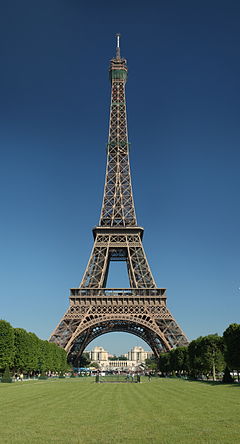The Eiffel Tower was once criticized for its design. It is now, and has been for some time, one of the most recognized and visited structures in the world.
France was planning for the World's Fair in 1889, to celebrate the 100th anniversary of the beginning of the French Revolution. A pair of engineers and an architect drew up the plans and submitted them to a company run by Gustave Eiffel. Eiffel liked the plans and displayed them at a public exhibition in 1884. Not much happened for the next couple of years, but things ramped up again as the year of the World's Fair, or Exposition Universelle, approached. The Exposition approved the plans in 1887.

The response to the official announcement of what came to be called the Eiffel Tower was mixed, with some opposition coming from a group of well-known artists, among them writers, painters, sculptors, and architects. Many in the scientific community doubted that the tall tower could withstand strong winds. The Tower, envisioned as the entrance to the Exposition, had powerful support from many in the business community, however, and so the project began, with foundation construction commencing on January 28, 1887.
Two of the four legs were close to the river Seine and needed more support than the other two legs. Much extra effort later, the legs were in place. Ironwork began.
The first level was complete in March 1888. Five months later, the second level was finished. Just after Christmas that same year, workers finished off the upper stage. The crowning achievement, the cupola, was completed in March 1889.
Eiffel himself led a group of dignitaries to the top of the Tower on March 31, 1889. The Exposition opened on May 6. When it closed, on Halloween, nearly 2 million visitors had made it to the top of the Eiffel Tower.
A cannon fired from the top of the Tower announced the daily opening and closing of the Exposition. Hundreds of gas lamps and a beacon sent out beams of blue, red, and white light (colors of the French flag) after dark.
The second level of the Tower contained an office and printing press for the newspaper Le Figaro. The third level of the Tower had a post office and wall-mounted sheets of paper for visitors to write messages. These sheets of paper were replaced daily.
Such a large structure needed a large amount of planning and preparation. Builders created more than 5,000 drawings in all. The number of different parts needed for completion of the entire tower exceeded 18,000. The number of rivets needed to join all of these parts was about 2.5 million.
The Tower was intended for demolition in 1909 and was a target for destruction several times after that. Eiffel, however, was successful in his attempt to keep the Tower by proving its worth as a resource for scientific experiments and for communication purposes.
In the scientific vein, several "first flights" were launched from the Eiffel Tower, by operators of parachutes, airships, and airplanes. The height of the Tower proved useful for conductors of various physics experiments.
A radio transmitter in the heights of the Eiffel Tower jammed German radio communications during World War I. Experimental television transmissions emanated from the Tower in 1935. A radio aerial erected in 1957 is intact.
As of 2014, more than 250 million people have visited the Eiffel Tower. It is the most-visited paid monument in the world.